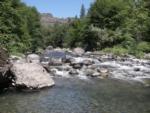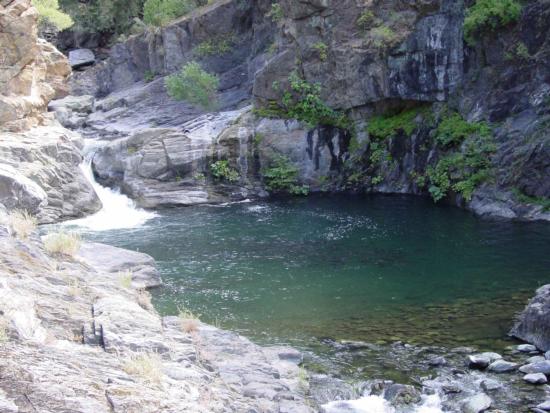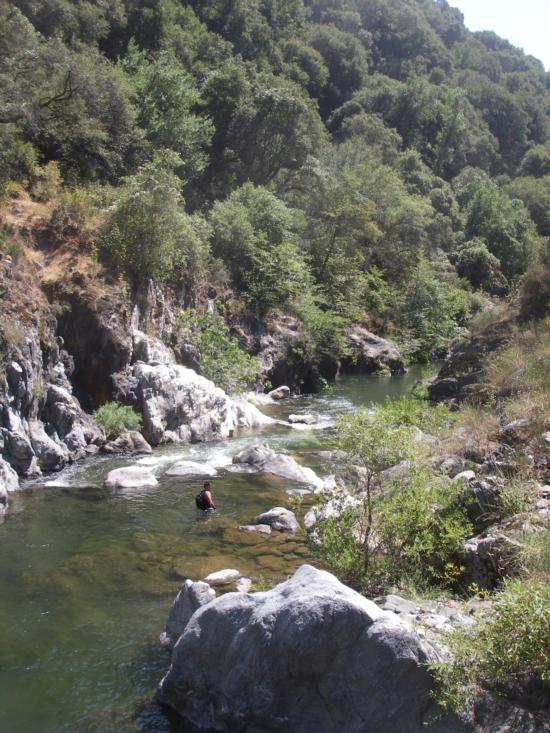Climate Change and Spring-Run Chinook Salmon
-
IssueSpring-run Chinook salmon (Oncorhynchus tshawytscha) are vulnerable to climate change because adults over-summer in freshwater streams before spawning in autumn. In California’s Central Valley their distribution is limited to three watersheds with small numbers appearing intermittently in seven other watersheds where access to coldwater pools remains unobstructed. Annual spring-run Chinook salmon runs used to number approximately 1 million fish, but they have declined to approximately 16,000 in the Central Valley.

-
Objectives
We sought to determine which future streamflow and water temperature regimes could lead to long-term reductions in spring-run Chinook salmon in a California stream and evaluate management adaptations to ameliorate these impacts. Climate change scenarios for California generally predict warming atmospheric temperatures, reduced snow pack and snow melt runoff, and lower dry season flows. The hydrologic response of a watershed to changing climatic forcing is the result of multiple non-linear physical processes that unfold within a system substantially manipulated by the operation of hydraulic infrastructure governed by a set of discontinuous conditional rules and agreements. The complex, non-linear nature of these systems makes it extremely difficult to construct a simple mental model of the relationship between increasing atmospheric temperature and the future viability of salmon within critical habitat segments. It is even more challenging to determine what management actions might be able to mitigate climate change effects when land use/land cover change, urbanization, and rapid human population growth have increasing impacts on management of water resources in California.
-
Research Activities
We developed an analytical framework that incorporates 1) climate scenarios, 2) a model of watershed response to climate change, including the capacity to model water management adaptations, and 3) a model of salmon population dynamics. We used the framework to examine the viability of the spring-run Chinook salmon population in Butte Creek under current management arrangements and under two relatively simple management changes within the system, across a range of climate predictions. We used bias-corrected and spatially downscaled climate data from six General Circulation Models and two emission scenarios for the period 2010 – 2099, as input to two linked models: WEAP to simulate weekly mean streamflow and water temperature in Butte Creek, California that was used as input to SALMOD, a spatially explicit and size/stage structured model of salmon population dynamics in freshwater systems.
-
Results
Under these climate scenarios WEAP yielded lower summer base flows and higher water temperatures relative to historical conditions, while SALMOD yielded increased adult summer thermal mortality and population declines for all climate scenarios and model combinations. Specifically, the analysis revealed that it is plausible to expect that the system will tip past critical thresholds some time during the second half of the 21st Century. However, water management adaptations may extend the survival of threatened salmon populations on the time scale of decades. Of management adaptations tested, only ceasing water diversion for power production from the summer holding reach resulted in cooler water temperatures, more adults surviving to spawn, and extended population survival time, albeit with a significant loss of power production. Without changes in water management, spring run Chinook salmon are likely to go extinct in Butte Creek and elsewhere in California.
-
Outcomes and Impacts
Linked analytical frameworks like the one presented here can guide adaptation of water management regimes to protect important ecosystem services. Furthermore, our results to date imply that management options available with current infrastructure need to be fine tuned to obtain the maximum benefit from power production while significantly reducing SRCS vulnerability to extinction. Our work has been submitted for peer-review and has been presented to Butte Creek stakeholders (including resource management agencies and power utilities), at numerous state and national conferences, and to the California Energy Commission.
-
Photos
 Spring-run Chinook salmon in Quartz Bowl Pool, Butte Creek, CA, in 2001. Photo by Allen Harthorn, Friends of Butte Creek.
Spring-run Chinook salmon in Quartz Bowl Pool, Butte Creek, CA, in 2001. Photo by Allen Harthorn, Friends of Butte Creek. California Department of Fish and Game crew member conducts Butte Creek salmon summer mortality survey, Aug. 10, 2009. Photo by Lisa Thompson.
California Department of Fish and Game crew member conducts Butte Creek salmon summer mortality survey, Aug. 10, 2009. Photo by Lisa Thompson. -
Supporting Information
Thompson, L.C., Escobar, M.I., Mosser, C.M., Purkey, D.R., Yates, D., Moyle, P.B. 2012. Water management adaptations to prevent loss of spring-run Chinook salmon in California under climate change. J. Water Resour. Plann. Manage. 138(5), 465-478 (2012); http://dx.doi.org/10.1061/(ASCE)WR.1943-5452.0000194 Online Publication Date: 29 Aug 2011 Download
Mosser, CM, Thompson LC, Strange JS. 2013. Survival of captured and relocated adult spring-run Chinook salmon Oncorhynchus tshawytscha in a Sacramento River tributary after cessation of migration. Environmental Biology of Fishes 96(2): 405-417. Published online 24 July 2012, DOI: 10.1007/s10641-012-0046-x Download
-
Acknowledgements
This project was funded by the US Environmental Protection Agency STAR Grant Program.
-
For more information contact
Dr. Lisa C. Thompson
Wildlife, Fish, & Conservation Biology Department
University of California, DavisEmail: lcthompson@ucdavis.edu
Phone: (530) 754-5732



